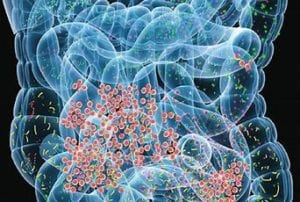Written by Joyce Smith, BS. A 16-week supplementation with the prebiotic oligofructose-enriched inulin significantly altered the intestinal microbiota and decreased body weight and fat and IL-6 levels in the participating obese and overweight children.
 Our gut microbiome functions in a symbiotic relationship to support healthy metabolism and body weight. Dysbiosis, an imbalance in the gut microbiota, is associated with metabolic diseases such as obesity and type 2 diabetes (T2D). 1 High fat and high fructose diets promote increased levels of inflammatory lipopolysaccharides (LPS), leading to low-grade inflammation called metabolic endotoxemia. 2-4.
Our gut microbiome functions in a symbiotic relationship to support healthy metabolism and body weight. Dysbiosis, an imbalance in the gut microbiota, is associated with metabolic diseases such as obesity and type 2 diabetes (T2D). 1 High fat and high fructose diets promote increased levels of inflammatory lipopolysaccharides (LPS), leading to low-grade inflammation called metabolic endotoxemia. 2-4.
Prebiotics, digestible food ingredients that promotes the growth of beneficial gut microorganisms, can restore beneficial gut bacteria such as Bifidobacterium and Lactobacillus and improve health. 5,6 In a single-center, randomized, double-blind, placebo-controlled trial by Nicolucci et al ( ), overweight or obese 7-10 year old children from the Alberta Children’s Hospital in Alberta, Canada received either 8 g/day of the prebiotic oligofructose-enriched inulin (OI)(n=22) or maltodextrin placebo daily (n=20) for 16 weeks. Blood samples were collected at baseline and 16 weeks to determine lipids, cytokines, lipopolysaccharide, and insulin. Bile acids were profiled using high-performance liquid chromatography, and fecal samples, also collected at baseline and 16 weeks, were analyzed for microbial composition using 16S rRNA sequencing and quantitative polymerase chain reaction.
- After 16 weeks, children who consumed the inulin (OI) demonstrated a significant decreases in body weight z-scores, body fat and trunk fat trunk fat (3.1%, 2.4% and 3.8% respectively) compared to children receiving the placebo (increase of 0.5%, increase of 0.05%, and decrease of 0.3%, respectively)
- Levels of Interleukin 6 (IL-6), a proinflammatory cytokine, were significantly reduced by 15 % from baseline in children receiving OI compared to a 25% increase in the placebo group.
- Children in the OI group also had a significant 19% decrease in serum triglycerides (often elevated in obesity)
- OI altered the gut microbial community composition, significantly increasing the abundance of Bifidobacterium species (p=0.023) and decreasing Bacteroides vulgatus in the OI group over the 16-week study.
- Significant and positive correlations were found with changes in body weight, fat mass, and BMI and changes in Clostridium clostridioforme, trunk body fat Bacteroides vulgatus, IL-6 with Clostridium clostridioforme, and triglycerides with Ruminococcus gauvreauii.
The study population was primarily Caucasian and middle to high socioeconomic status, which might reduce generalizability to over nourished people with diabetes and liver disease or to children of various ethnicities and diets that differ from this small cohort of children. The study does, however, demonstrate that manipulation of intestinal bacteria by inexpensive and non-invasive prebiotics may be a feasible intervention for obesity prevention or treatment.
Source: Nicolucci, Alissa C., Megan P. Hume, Inés Martínez, Shyamchand Mayengbam, Jens Walter, and Raylene A. Reimer. “Prebiotics reduce body fat and alter intestinal microbiota in children who are overweight or with obesity.” Gastroenterology 153, no. 3 (2017): 711-722. © 2017 by the AGA Institute.
Published by Elsevier. This is an open access article under the CC BY-NC-ND license (http://creativecommons.org/licenses/by-nc-nd/4.0/) http://dx.doi.org/10.1053/j.gastro.2017.05.055
Click here to read the full text study.
Posted February 11, 2019.
Joyce Smith, BS, is a degreed laboratory technologist. She received her bachelor of arts with a major in Chemistry and a minor in Biology from the University of Saskatchewan and her internship through the University of Saskatchewan College of Medicine and the Royal University Hospital in Saskatoon, Saskatchewan. She currently resides in Bloomingdale, IL.
References:
- Arora T, Bäckhed F. The gut microbiota and metabolic disease: current understanding and future perspectives. Journal of internal medicine. 2016;280(4):339-349.
- Cani PD, Rodrigo B, Knauf C, et al. Changes in gut microbiota control metabolic endotoxemia-induced inflammation in high-fat diet-induced obesity and diabetes in mice. Diabetes. 2008.
- Cani PD, Amar J, Iglesias MA, et al. Metabolic endotoxemia initiates obesity and insulin resistance. Diabetes. 2007;56(7):1761-1772.
- Spruss A, Kanuri G, Stahl C, Bischoff SC, Bergheim I. Metformin protects against the development of fructose-induced steatosis in mice: role of the intestinal barrier function. Laboratory investigation. 2012;92(7):1020.
- Gibson GR, Scott KP, Rastall RA, et al. Dietary prebiotics: current status and new definition. Food Sci Technol Bull Funct Foods. 2010;7(1):1-19.
- Bindels LB, Delzenne NM, Cani PD, Walter J. Towards a more comprehensive concept for prebiotics. Nature reviews Gastroenterology & hepatology. 2015;12(5):303.
